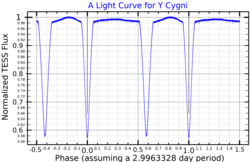
V1500 Cygni or Nova Cygni 1975 was a bright nova occurring in 1975 in the constellation Cygnus. It had the second highest intrinsic brightness of any nova of the 20th century, exceeded only by CP Puppis in 1942.

74 Aquarii is a triple star system in the constellation of Aquarius. 74 Aquarii is its Flamsteed designation and it also bears the variable star designation HI Aquarii. The combined apparent visual magnitude is 5.8, although it is very slightly variable, and it is located at a distance of 590 light-years from Earth.

Delta Cygni is a binary star of a combined third-magnitude in the constellation of Cygnus. It is also part of the Northern Cross asterism whose brightest star is Deneb. Based upon parallax measurements obtained during the Hipparcos mission, Delta Cygni is located roughly 165 light-years distant from the Sun.

32 Cygni is the Flamsteed designation for a binary star system in the Cygnus constellation. It is a 4th magnitude star, which can be seen with the naked eye under suitably dark skies. Parallax measurements give an estimated distance of 1,100 light-years (320 parsecs) from the Earth. However, Schröder et al. (2007) suggest the actual value, after correcting for Malmquist bias, may be closer to 1,174 light-years (360 parsecs). Although it is a spectrsocopic binary with components that cannot be separated visually, it has two entries in the Henry Draper Catalogue, with identical magnitudes and positions, but showing the spectral types of the two components.

HR Carinae is a luminous blue variable star located in the constellation Carina. It is surrounded by a vast nebula of ejected nuclear-processed material because this star has a multiple shell expanding atmosphere. This star is among the most luminous stars in the Milky Way. It has very broad emission wings on the Balmer lines, reminiscent from the broad lines observed in the spectra of O and Wolf–Rayet stars. A distance of 5 kpc and a bolometric magnitude of -9.4 put HR Car among the most luminous stars of the galaxy.

V381 Cephei is a triple star system in the northern constellation of Cepheus. Its apparent magnitude is slightly variable between 5.5 and 5.7.
Lambda Cygni is a class B5V star in the constellation Cygnus. Its apparent magnitude is 4.54 and it is approximately 770 light years away based on parallax.

47 Cygni is a triple star system in the northern constellation of Cygnus, and is located around 4,000 light years from the Earth. It is visible to the naked eye with a combined apparent visual magnitude of 4.61. The system is moving closer to the Earth with a heliocentric radial velocity of −4.6 km/s.

1 Persei is an eclipsing binary star in the constellation Perseus. Its uneclipsed apparent magnitude is 5.49. The binary star consists of two B2 type main-sequence stars in a 25.9 day eccentric orbit. The stars are surrounded by a faint cloud of gas visible in mid-infrared, although whether they are the origin of the gas or simply passing through it is unclear.

W Cygni is a semi-regular variable star in the constellation Cygnus, located 570 light-years from Earth. It lies less than half a degree southeast of ρ Cygni. W Cygni is, at times, a naked-eye star but it was not given a Bayer or Flamsteed designation. It has been proposed as a binary star system with a hotter main sequence companion, but this has not been confirmed.

31 Cygni, also known as ο1 Cygni, Omicron1 Cygni, or V695 Cygni, is a triple star system about 750 light years away in the constellation Cygnus.

ZZ Boötis is a star system in the constellation Boötes. It varies from magnitude 6.79 to 7.44 over five days. Based on its parallax, measured by the Gaia spacecraft, it is about 350 light-years away.
EQ Pegasi is a nearby binary system of two red dwarfs. Both components are flare stars, with spectral types of M4Ve and M6Ve respectively, and a current separation between the components of 5.8 arcseconds. The system is at a distance of 20.4 light-years, and is 950 million years old. The primary star is orbited by one known exoplanet.
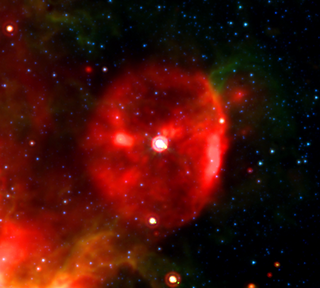
HDE 316285 is a blue supergiant star in the constellation Sagittarius. It is a candidate luminous blue variable and lies about 6,000 light years away in the direction of the galactic centre.

BC Cygni is a red supergiant and pulsating variable star of spectral type M3.5Ia in the constellation Cygnus.

RW Cygni is a semiregular variable star in the constellation Cygnus, about a degree east of 2nd magnitude γ Cygni. Its apparent magnitude varies between 8.05 and 9.70 and its spectral type between M3 and M4.
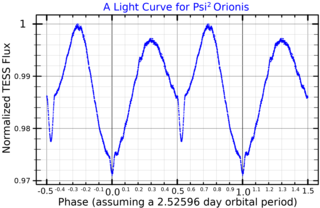
Psi2 Orionis a binary star system in the equatorial constellation of Orion. It has an apparent visual magnitude of 4.6, indicating that it is visible to the naked eye. Based upon an annual parallax shift of 2.87 mass, it is roughly 1,100 light years distant from the Sun.
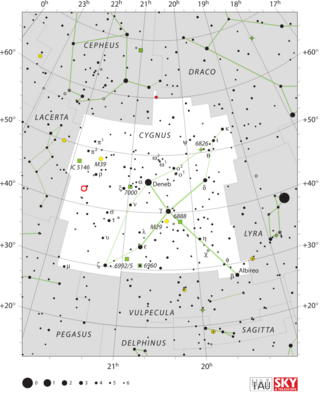
Q Cygni, is a star located in the constellation Cygnus. It is also known as Nova Cygni 1876, and has the designation NGC 7114, and HR 8296. Nova Cygni is located in the northwestern portion of Cygnus along the border with Lacerta.
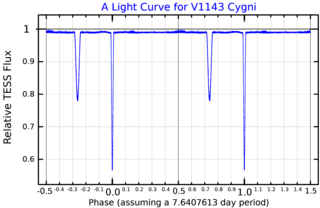
HR 7484 is a binary star system in the northern constellation of Cygnus. It is dimly visible to the naked eye under good viewing conditions, having an apparent visual magnitude of 5.89. Based upon an annual parallax shift of 24.71, it is located 132 light years away. The system is moving closer with a heliocentric radial velocity of −14 km/s.

CH Cygni is a red giant, variable, symbiotic binary in the constellation Cygnus. It is the nearest symbiotic star to Earth, and one of the brightest, making it an ideal candidate for study.
